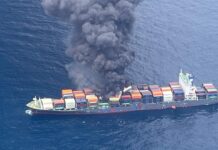
The South Korean government wants to boost the container carrying capacity of the country’s liner operators to 1.2 million TEU by 2025.
The Minister for Oceans and Fisheries, Moon Seong-hyeok, announced, on 12 August, a development to the five-year plan that was originally unveiled in 2017 to revive the country’s maritime industry after Hanjin Shipping collapsed.
State-backed ship finance institution Korea Ocean Business Corporation will provide the capital for ship owners to order new ships or acquire vessels, through sale-and-leaseback arrangements.
Despite the perceived failure of the Korea Shipping Partnership, Moon asserted that the quasi-alliance of 14 South Korean liner operators had some success.
He said, “Sinokor Merchant Marine and Heung-A Shipping merged their container businesses to become one the world’s top 20 liner operators. This resulted in a 12.9% increase in sales and a turnaround in operating profit. Through restructuring three intra-Asian routes, the supply of 13 vessels has been adjusted to eliminate excessive competition among South Korean carriers.
Moon also said that the five-year plan should also take some credit for HMM finally achieving a profitable Q2 this year, after 21 consecutive quarterly losses.
He said, “What made HMM’s profit possible after 21 quarters? I think it is the five-year plan, which helped HMM to expand its fleet from 590,000TEU to 1 million TEU, [including those on order] while establishing new services to the Middle East and South America.”
Moon however, said that the government’s target is for HMM to achieve a full-year net profit for 2022, notwithstanding recessionary pressures from Covid-19.
He added, “We don’t think HMM has completely normalised its operations just because of one profitable quarter. We need to further enhance the five-year plan. The Covid-19 pandemic only means there’s an urgent need to provide liquidity.”
The enhanced plan will see the government helping liner operators secure container storage facilities in China and strengthen inland transportation in the Americas and Europe through collaboration with US rail operators and developing a truck-air transport service in Europe.
Moon also alluded to growing competition in the East Asia-Southeast Asia routes, which he described as a new battlefield in container shipping.
He said, “With state support, South Korean carriers can compete with global shipping companies on an equal footing. We plan to provide support for essential operating assets such as ship finance and containers, as well as working capital.”
Martina Li
Asia Correspondent








